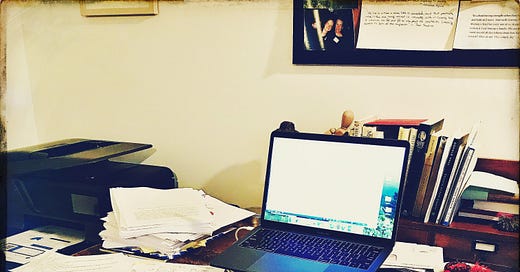…to be at my desk in my studio on the third floor is to be in interiority, which is, I think, a place that’s almost becoming obsolete in our culture—the interior world, and to be in reverie. And it’s difficult to maintain that discipline, because like anything if you don’t do it, the threshold becomes painful to reenter. - Marie Howe, in conversation with Koshin Paley Ellison and Robert Chodo Campbell
In my home office, I have two desks. The one I’m sitting at right now, where I am writing to you on my laptop perched on a thick cookbook set upon a stand (because I am quite short and often get a stiff neck if my computer is situated at the wrong height), is an antique Irish pine behemoth facing a wall. Hanging on the wall is a bulletin board covered in old photos, an invitation to contribute an essay to an anthology on shame, two index cards (one with the first lines of another essay I’m currently writing, about sexual fluidity in the Seventies), a Cheryl Strayed quote about resilience in the writing process, and a yellowing piece of paper emblazoned with the last words of Seamus Heaney, which I also have tattooed on my left arm: Noli Timere. Also on this desk: piles of paper, a modem, a router, a podcasting microphone, a small bookshelf, a black glass bottle that used to contain expensive California olive oil, a hardcover copy of Zadie Smith’s Feel Free, and a massive light box because I live in New England, where winters are dark.
My other desk, which faces the window out to my backyard, is small and Mission-style, dark oak, with a drawer that, when you pull it open, reveals a secret hinged box in which I keep Things. I found this desk in an antique store in Soho many years ago, and for a long time it sat unused in our guest room until I decided to move it in here, under the window. It gets perfect light, and on it I keep my wife’s late uncle’s oak tool box, its small drawers filled with original tools from the 1930s, which, when they come and visit us, I will be giving to my dear friend RF Jurjevics, who creates remarkable things with their hands. Perched on the toolbox is a tiny Ganesha, to remind me to get out of my own way. The desk chair — different from the thousand-dollar Aeron chair I’m sitting on as I write this — is my wife’s grandmother’s Windsor chair, probably from the 1920s or earlier.
The danger is not lack of time for interiority; the danger is distraction, and the addictive lure of comparison and competition.
Two very different desks; two very different jobs. Both creative. I teach from the former, do Zoom calls, write various commissioned pieces, put out daily eldercare fires, conduct business, organize taxes, pay bills. My plan was to write — just write, by hand — at the latter, facing out the window at the massive lilac that blooms every June.
Years ago, I wrote anywhere, on anything, at any time. In the early 1990s, after cooking school, I was briefly temping for a famous Manhattan advertising agency and because I wasn’t staff, I spent a lot of time just sitting at my desk, reading anything that crossed my path. And because I had access to stacks of pads, I spent hours — literally, hours — writing by hand, until one of the people I worked for asked me to Xerox something for them, or get them coffee, or make them an appointment. Days often went by where my services weren’t needed, so I read, or I wrote. When I was moved to another department, there were no pads available — it was just me and a phone — so I took to writing on the inside front covers of the paperbacks I was reading (I couldn’t afford hardcovers), all over the frontmatter, all over the backmatter, and on the inside back cover; it never occurred to me to buy a notebook, and I have no idea why. I’d forgotten about this until recently, when I was in our basement and I opened a box, blew the dust off a Natalie Goldberg book and discovered my wild, young, blathering-not-entirely-awful-but-slightly-overwrought writing all over its front and backmatter.
Keep reading with a 7-day free trial
Subscribe to Poor Man's Feast to keep reading this post and get 7 days of free access to the full post archives.






